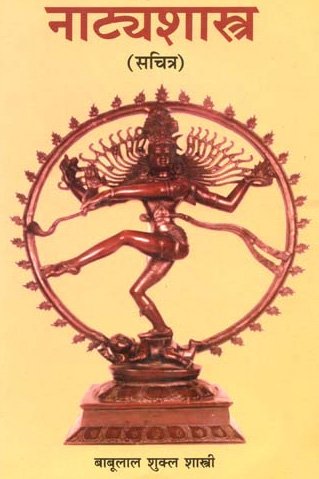Your cart is currently empty!
āhāryābhinaya
—
by
ĀhāryābhinayaĀhāryābhinaya (आहार्याभिनय) refers … More (आहार्याभिनय) refers to the “extraneous representation”, a critical factor for a successfull dramatic play, according to Nāṭyaśāstra chapter 23. This part of theatrics is mainly concerned with nepathya, “costumes and make-up”.
Source: archive.org: Illustrations of Indian Music and Dance in Western Indian Style (natya)
Āharyābhinaya (आहर्याभिनय) or simply āharya refers to the first of four categories of abhinaya (histrionic representation). Āharya-abhinaya deals with costumes, ornaments, make-up and decorations. Abhinaya is the imitation of the thing seen by self or is an expression of sentiment experienced by oneself.
Source: Indian Classical Dances: Techniques of classical dances
Aharya (or external): One of the four Abhinaya (expressional aspect of dance). It is expression, mood and background as conveyed by costume, make-up, accessories and sets: Dress and the appearance of actors. Costume is a very essential feature of a dance and there is costume for every character taking part.
Source: Shodhganga: The significance of the mūla-beras (natya)
ĀhāryābhinayaĀhāryābhinaya (आहार्याभिनय) refers … More (आहार्याभिनय) refers to the “extraneous representation” and represents one of the four kinds of abhinaya (“histrionic representation”) as used within the classical tradition of Indian dance and performance, also known as Bharatanatyam.—Āhāryābhinaya or extraneous representation is the art of expression through decoration such as make-up, jewellery, costumes, stage settings and scenery. Indian classical dances have always been costume oriented because of the rich heritage of India in textiles.
Chapter 23 of Nāṭyaśāstra speaks of the āhāryābhinayaĀhāryābhinaya (आहार्याभिनय) refers … More in detail. From these details one comes to know of the knowledge Bharata had and the importance he gave to āhāryābhinayaĀhāryābhinaya (आहार्याभिनय) refers … More in dramatic representation. In a solo dance performance, the āhārya often remains the same throughout the recital. The āhāryābhinayaĀhāryābhinaya (आहार्याभिनय) refers … More should not dominate the performance but it should act as a support to the dance. In a dance drama each character is dressed up in appropriate costumes and physical decoration. This helps the audience to trace the character as soon as the artist enters the stage without the use of the other three abhinayas.
Source: Shodhganga: Elements of Art and Architecture in the Trtiyakhanda of the Visnudharmottarapurana (natya)
ĀhāryābhinayaĀhāryābhinaya (आहार्याभिनय) refers … More (आहार्याभिनय) or simply Āhārya refers to one of the four divisions of Abhinaya or “ways to convey or represent one’s emotion to others” (in Sanskrit Drama), according to the Viṣṇudharmottarapurāṇa, an ancient Sanskrit text which (being encyclopedic in nature) deals with a variety of cultural topics such as arts, architecture, music, grammar and astronomy.—Abhinaya (“acting”) is of four varieties, according to the Viṣṇudharmottarapurāṇa. ĀhāryābhinayaĀhāryābhinaya (आहार्याभिनय) refers … More is conveyed by decoration or ornamentation. In the Nāṭyaśāstra, it is said that the entire production of a play depends on āhāryābhinayaĀhāryābhinaya (आहार्याभिनय) refers … More and the extraneous representation deals with the rules of costumes and make-up. Till today, this process is followed and the actors go for their make-up in the greenroom which is generally situated in the back stage.

Natyashastra (नाट्यशास्त्र, nāṭyaśāstra) refers to both the ancient Indian tradition (shastra) of performing arts, (natya—theatrics, drama, dance, music), as well as the name of a Sanskrit work dealing with these subjects. It also teaches the rules for composing Dramatic plays (nataka), construction and performance of Theater, and Poetic works (kavya).
